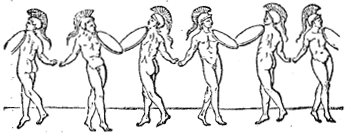Gymnopaedia
Gymnopaedia was an ancient Spartan festival celebrated annually in honor of Apollo and Artemis. The name Gymnopaedia, derived from the Greek words gymnos (naked) and paideia (instruction), translates to "naked festival" or "festival of naked youths". This event was one of the most important in Spartan society, showcasing the military prowess, athleticism, and cultural values of the city-state.
Origins and History[edit | edit source]
The origins of the Gymnopaedia are shrouded in the mists of ancient history, with its inception likely rooted in the Spartan tradition of military excellence and physical fitness. It was believed to have been established to honor the memory of Spartans who had fallen in battle, particularly those who died during the Messinian Wars, a series of conflicts between Sparta and the neighboring region of Messinia.
Celebration and Activities[edit | edit source]
During the Gymnopaedia, young Spartan males participated in various activities and competitions, which included gymnastics, wrestling, music, and dance. These events were performed in the nude, emphasizing the Spartan ideals of physical beauty, strength, and the exhibition of the male body in its prime. The festival also served as a training ground for young warriors, highlighting the skills and disciplines necessary for battle.
Music and dance played a significant role in the Gymnopaedia. The performances were not only a display of physical agility but also a means to express Spartan values, such as harmony, order, and discipline. These artistic expressions were intertwined with the martial aspect of Spartan culture, reflecting the city-state's unique blend of military and cultural practices.
Cultural Significance[edit | edit source]
The Gymnopaedia held deep cultural significance for the Spartans. It was a time when the community came together to celebrate their youth, military strength, and cultural heritage. The festival also served as an educational tool, instilling in young Spartans the values and disciplines necessary for their role in society, both as warriors and as citizens.
In addition to its focus on physical prowess and military training, the Gymnopaedia underscored the importance of music, dance, and the arts in Spartan society. These elements were integral to the Spartan education system, known as the Agoge, which aimed to produce well-rounded citizens capable of contributing to all aspects of Spartan life.
Legacy[edit | edit source]
The legacy of the Gymnopaedia extends beyond the ancient world, influencing modern perceptions of Spartan culture and the ideal of the warrior-artist. The festival is often cited as an example of the unique blend of martial and cultural excellence that characterized Spartan society.
In contemporary times, the Gymnopaedia has inspired various cultural and artistic works, reflecting the enduring fascination with Sparta and its traditions. While the original festival is no longer celebrated, its spirit lives on in the study of ancient Greek history and culture, serving as a testament to the complex and multifaceted nature of Spartan society.
This Ancient Greece related article is a stub. You can help WikiMD by expanding it.
Search WikiMD
Ad.Tired of being Overweight? Try W8MD's physician weight loss program.
Semaglutide (Ozempic / Wegovy and Tirzepatide (Mounjaro / Zepbound) available.
Advertise on WikiMD
|
WikiMD's Wellness Encyclopedia |
| Let Food Be Thy Medicine Medicine Thy Food - Hippocrates |
Translate this page: - East Asian
中文,
日本,
한국어,
South Asian
हिन्दी,
தமிழ்,
తెలుగు,
Urdu,
ಕನ್ನಡ,
Southeast Asian
Indonesian,
Vietnamese,
Thai,
မြန်မာဘာသာ,
বাংলা
European
español,
Deutsch,
français,
Greek,
português do Brasil,
polski,
română,
русский,
Nederlands,
norsk,
svenska,
suomi,
Italian
Middle Eastern & African
عربى,
Turkish,
Persian,
Hebrew,
Afrikaans,
isiZulu,
Kiswahili,
Other
Bulgarian,
Hungarian,
Czech,
Swedish,
മലയാളം,
मराठी,
ਪੰਜਾਬੀ,
ગુજરાતી,
Portuguese,
Ukrainian
Medical Disclaimer: WikiMD is not a substitute for professional medical advice. The information on WikiMD is provided as an information resource only, may be incorrect, outdated or misleading, and is not to be used or relied on for any diagnostic or treatment purposes. Please consult your health care provider before making any healthcare decisions or for guidance about a specific medical condition. WikiMD expressly disclaims responsibility, and shall have no liability, for any damages, loss, injury, or liability whatsoever suffered as a result of your reliance on the information contained in this site. By visiting this site you agree to the foregoing terms and conditions, which may from time to time be changed or supplemented by WikiMD. If you do not agree to the foregoing terms and conditions, you should not enter or use this site. See full disclaimer.
Credits:Most images are courtesy of Wikimedia commons, and templates, categories Wikipedia, licensed under CC BY SA or similar.
Contributors: Prab R. Tumpati, MD





